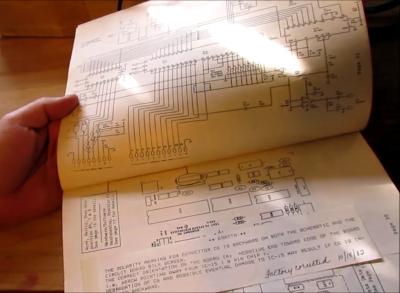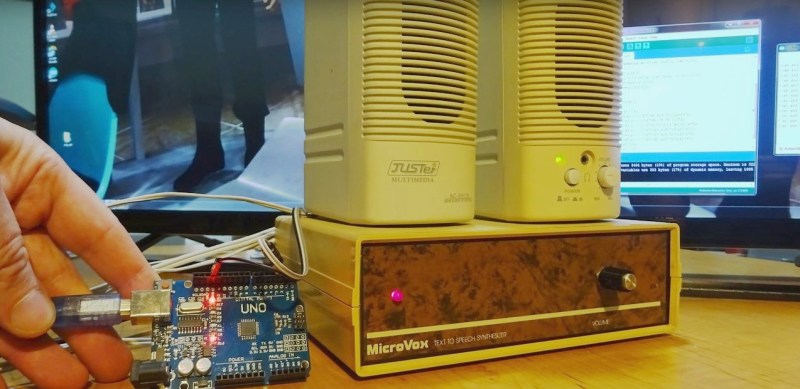[Monta Elkins] got it in his mind that he wanted to try out an old-style speech synthesizer with the SC-01 (or SC-01A) chip, one that uses phonemes to produce speech. After searching online he found a MicroVox text-to-speech synthesizer from the 1980s based around the chip, and after putting together a makeshift serial cable, he connected it up to an Arduino Uno and tried it out. It has that 8-bit artificial voice that many of us remember fondly and is fairly understandable.
The SC-01, and then the SC-01A, were made by Votrax International, Inc. In addition to the MicroVox, the SC-01 and SC-01A were used in the Heath Hero robot, the VS-100 synthesizer add-on for TRS-80s, various arcade games such as Qbert and Krull, and in a variety of other products. Its input determines which phonemes to play and where it shines is in producing good transitions between them to come up with decent speech, much better than you’d get if you just play the phonemes one after the other.
 The MicroVox has a 25-pin RS-232 serial port as well as a parallel port and a speaker jack. In addition to the SC-01A, it has a 6502 under the hood. [Monta] was lucky to also receive the manual, and what a manual it is! In addition to a list of the supported phonemes and words, it also contains the schematics, parts list and details for the serial port which alone would make for fun reading. We really liked the taped-in note seen in this screenshot. It has a hand-written noted that says “Factory Corrected 10/18/82”.
The MicroVox has a 25-pin RS-232 serial port as well as a parallel port and a speaker jack. In addition to the SC-01A, it has a 6502 under the hood. [Monta] was lucky to also receive the manual, and what a manual it is! In addition to a list of the supported phonemes and words, it also contains the schematics, parts list and details for the serial port which alone would make for fun reading. We really liked the taped-in note seen in this screenshot. It has a hand-written noted that says “Factory Corrected 10/18/82”.
Following along with [Monta] in the video below, he finds the serial port’s input buffer chip datasheet online and verifies the voltage levels. Next he opens up the case and uses dips switches to set baud rate, data bits, parity, stop bits and so on. After hooking up the speakers, putting together a makeshift cable for RX, TX and ground, and writing a little Arduino code, he sends it text and out comes the speech.
The SP-01 wasn’t the only speech chip from the 1980s we’ve come across. [Marquis de Geek] used the SP0256 to make what he calls a homemade Stephen Hawking. And Votrax themselves had their own speech box, the Type ‘N Talk, which was often used to give a voice to the VIC-20. But [Jan] didn’t have one so he used an Android phone instead to give voice to old text adventure games running on his VIC-20.

















is that the thing used for music way back then ? kraftwerk keeps coming to my mind.. but that might be a blurred memory
I thought they used more vocoders? https://www.youtube.com/watch?v=5kc-bhOOLxE
most likely U96 songs i got it mixed up with :) or maybe MUSIC INSTRUCTOR :D :D :D
First thing that came to my mind was Frank Zappas album Thing Fish.
Yes. Sounds like one of those: https://www.youtube.com/watch?v=nKrEI_lN1xg
Nope. Kraftwerk used modified Speak ‘n’ Spell machines from Texas Instruments for the “computer voice” in tracks like It’s More Fun To Compute. They also used vocoders but that’s another kettle of fish.
I disagree… since its sounds much more like the Digital Equipment DECtalk, used by Stephen Hawking (still)
Hmm I think Alan Parsons Project was one of the first bands to use a vocoder
https://www.youtube.com/watch?v=YAE1XTvKLXA
Later the Heathkit Hero 2000 used the Silicon Systems SSI 263 . It had five eight bit registers for software control of speech rate, pitch, pitch movement rate, amplitude, articulation rate….and more than you really wanted!
Sounds like Coat and strippers.
correction to: “the Type ‘N Talk which [Jan] used to give voice to old text adventure games with an Android phone and VIC-20. The sound from this one really is remarkable, sounding pretty much the same as modern-day Siri.”
That is a project which uses a android phone app so you don’t need the type ‘N talk, so there is no surprises that it sounds modern… because it is modern. Jan never owned a type ‘N talk, that’s why he made the project with his phone.
Oops. Fixed. I guess I read that article a little to fast while sifting through possible related stuff.
Talk about things from the past! 35 years ago. Microvox!
OK, let me give you a little history. It was designed as a construction article by Steve Ciarcia in BYTE Magazine originally in September and October 1982 as part of the Ciarcia’s Circuit Cellar column in BYTE. The project is also reprinted in Ciarcia’s Circuit Cellar Volume 4 (all the books are scanned and available free from Google Books online) and also in the Best of Ciarcia’s Circuit Cellar book.
https://books.google.com/books/about/Ciarcia_s_Circuit_Cellar.html?id=zQWNinpbFx0C
There were a half dozen speech synthesizer projects over the years in Circuit Cellar. This one was in the middle of the batch and pretty sophisticated for its time. The reason the user’s manual has so much information and schematics was because of the premise of these projects. As with all Ciarcia’s projects BYTE readers could physically build their own Microvox from the articles (including downloading a free file of the 6502 microcontroller code) or if they had a volume application, buy them commercially after publication from Micromint. Mr. Dufresne didn’t mention it but the Microvox’s processor was also unique in its application because it had the capability to add inflection to an otherwise monotone synthesizer chip (his examples were only monotone).
Let me just say I’m happy that someone still enjoys my old projects and I still get a kick seeing all my long out of print project books still being sold on ebay (often for much more than their original price ;-)
I look forward to seeing more resurrected projects in Hackaday.
Thanks,
Steve Ciarcia
steve@circuitcellar.com
P.S. I also did a subsequent synthesizer project using the SSI263
Thanks for your hard work and for writing in, Steve :) Looks like I have some fun reading to do. I am interested in that SSI263 synth project. May you enjoy good health and keep tinkering :)
I’m in Florida now but back up north this summer. If you have trouble finding an SSI263 chip, contact me then. I may still have one around.
I’m pondering about the article mentioning he needed the datasheet to verify the voltages of the serial connector? Back then when a manufacturer put a 25-pin RS232 port on something it was at least +/-12V data out and should tolerate +/-30V in. No low level bend standards back then. It would also be wired as a serial peripheral device, i.e. the rx/tx pins were swapped as opposed to the RS-232 port on the computer. So a very strict maintained standard. However checking the sheets whether in doubt or not, is always a vise thing to do.
If I remember correctly “RS-232” merely said it was serial., The true designations of the RS-232 connection were supposed to have an A, B, or C at the end like RS-232C which designated the voltage. I believe, without looking it up, the C was +/- 15V. In truth, the transceivers used back then even for 15V would still work at +/-5V.
–Steve
I miss the days when computer peripherals came with such detailed documentation.
Best I can remember was some of the printers we had … no schematics, but they included documentation regarding the control codes used to select colours and built-in fonts.
Today, you’re lucky if they have pictorial diagrams showing you how to get it out of the box and turn it on!
How about a nice game of chess?
How about a nice game of LE DANK MAYMAYZ?!?!?!?!!!!!
Those speakers….90s edutainment software memories come flooding back to me.
First thing that came to mind:
“Matt-ell Elec-tron-ics pre-sents… Bee Sh-ev-en-teen Baww-Mer”